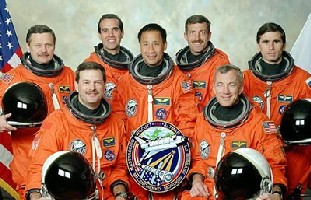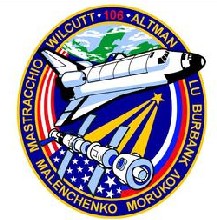September 08 - 20, 2000
Atlantis
The crew

(June 2000) --- Five NASA astronauts and two cosmonauts representing the Russian Aviation and Space Agency take a break in training from their scheduled September 2000 visit to the International Space Station. Astronauts Terrence W. Wilcutt (right front) and Scott D. Altman (left front) are mission commander and pilot, respectively, for the mission. On the back row are the mission specialists. They are (from left) cosmonaut Boris V. Morukov, along with astronauts Richard A. Mastracchio, Edward T. Lu and Daniel C. Burbank and cosmonaut Yuri I. Malenchenko. Morukov and Malenchenko represent the Russian Aviation and Space Agency.
The Artwork

This is the crew patch for the STS-106 mission, which is the first Shuttle flight to the International Space Station since the arrival of its newest component, the Russian-supplied Service Module Zvezda (Russian for star). Zvezda is depicted on the crew patch mated with the already orbiting Node 1 Unity module and Russian-built Functional Cargo Block, called Zarya (sunrise), with a Progress supply vehicle docked to the rear of the Station. The International Space Station is shown in orbit with Earth above as it appears from the perspective of space. The Astronaut Office symbol, a star with three rays of light, provides a connection between the Space Shuttle Atlantis and the Space Station, much the same as the Space Shuttle Program is linked to the International Space Station during its construction and future research operations. Stylized versions of flags from Russia and the United States meet at the Space Station. They symbolize both the cooperation and joint efforts of the two countries during the development and deployment of the permanent outpost in space as well as the close relationship of the American and Russian crew members.